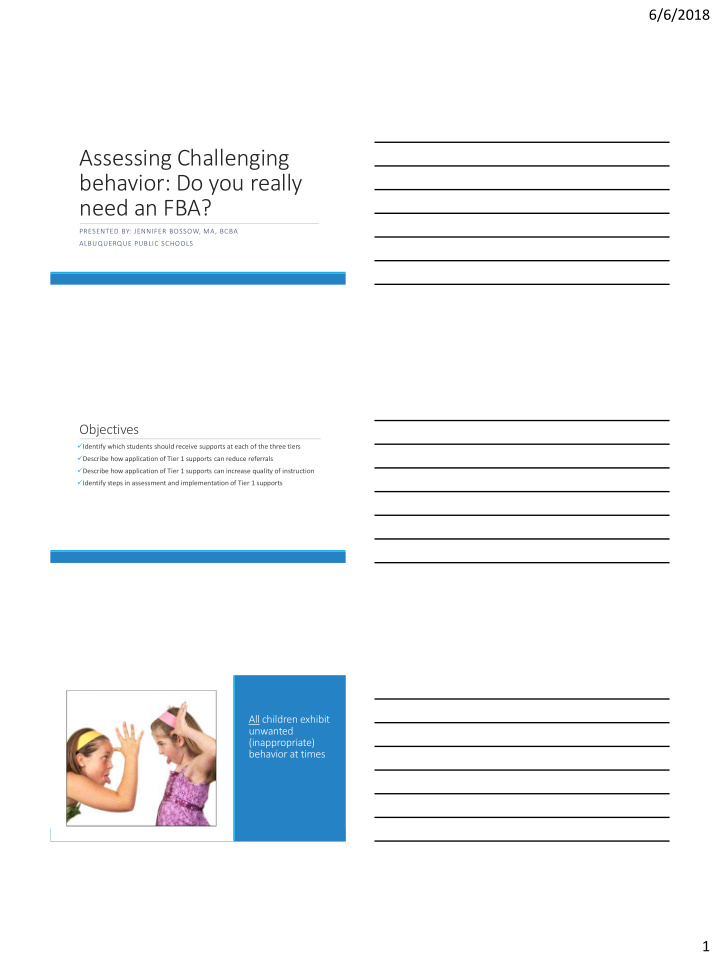



6/6/2018 Assessing Challenging behavior: Do you really need an FBA? PRESENTED BY: JENNIFER BOSSOW, MA, BCBA ALBUQUERQUE PUBLIC SCHOOLS Objectives Identify which students should receive supports at each of the three tiers Describe how application of Tier 1 supports can reduce referrals Describe how application of Tier 1 supports can increase quality of instruction Identify steps in assessment and implementation of Tier 1 supports All children exhibit unwanted (inappropriate) behavior at times 1
6/6/2018 Children also learn behavioral expectations vary among people, places and circumstances https://www.today.com/parents/driving-was-so-peaceful-dad-triplets-has-genius-fix-backseat-t103582 As most children enter school, undesirable behavior is more or less controlled by traditional means: Reminders to behave Infrequent reinforcement Reprimands Time outs Parent contacts 2
6/6/2018 What works for most doesn’t work for all MOST CHILDREN NEED TO EXPERIENCE MINOR 10% -30% OF SCHOOL AGE CHILDREN MAY NOT CONSEQUENCES ONCE IN AWHILE RESPOND TO METHODS THAT WORK FOR THROUGHOUT THEIR SCHOOL YEARS OTHER CHILDREN Scheuermann and Hall, 2016 Schools must be prepared to address the full range of student behavior. • Using a graduated system of positive interventions (a.k.a. positive behavior supports) • NM RTI process 3
6/6/2018 School-wide systems of support Emphasizing multiple levels of prevention Primary prevention strategies (universal intervention) (90% of students) ◦ Enhancing protective factors in schools to prevent students from falling into risk ◦ Ensuring and maintaining the use of effective practices for all students ◦ Example – School and classroom wide interventions Secondary prevention (targeted intervention) (7% -9% of students) ◦ Involves activities that provide support to students that are identified as at-risk to prevent the development of patterns problematic responding or concerning behavior that may lead to more serious behavior patterns ◦ Example – Systematic instruction in social skills for students with poor or inappropriate interactions Tertiary prevention (intensive intervention) (1% - 3% of students) ◦ Focuses on students requiring the most intensive, individualized supports through highly specialized services orchestrated by a team Kerr and Nelson, 2006 4
6/6/2018 In oth ther words . . . Slide. from Maryann Trott So what is a teacher to do? Focus on the school-based factors that affect behavior • Design of classroom management • Instructional systems Research supports that teachers’ actions in their classrooms are highly influential on student achievement (Scheuerman and Hall, 2016) Plan classroom and individual behavior management systems Have clear rules and expectations Give more attention to expected (wanted) behavior rather than unwanted (inappropriate) behavior Unwanted (inappropriate) behavior is dealt with systematically, consistently, and equitably 5
6/6/2018 Classroom Organization and Management Inventory (COMI) Modified from Janney, Bambara and Snell, 2015 Classroom Organization and Management Inventory What - a self assessment tool of effective classroom management practices and use in the classroom Purpose – determine the effectiveness of classroom management practices with a particular group of students in the classroom When – concerning behaviors are observed Why Polls of teachers, parents, and the public consistently cite discipline as major concern Most teachers receive insufficient training in research-based behavioral strategies that inappropriate behaviors or that allow educators to respond to concerning behaviors using positive educational approaches In a 2007 survey of first-year teachers, only 34% of the respondents reported that their teacher training coursework covered positive behavioral interventions as a method for classroom management **the better managed the classroom, the more time teachers have to teach and the more students are likely to learn ***the most important component of any behavior management program is prevention Scheuermann and Hall, 2016 6
6/6/2018 Wait a minute! Is this another teacher evaluation? “Directions: Use the rating scale to assess each evidence-based classroom organization and management practice. Individual teachers may use the inventory to self-assess, or team members may conduct observations of one another. Discuss strengths and areas of improvement. Target several weaker indicators for improvement. Although some areas may not seem relevant, please rate them to consider and/ or discuss with your team.” Using the COMI Classroom based supports ◦ Aware of the concerning behavior ◦ Using the tool to determine if classroom management techniques have an effect on the concerning behavior Let’s do one together 7
6/6/2018 Develop interventions Classroom Management Inventory Intervention Plan # Practice Current level of performance Strategies/ Data Collection(Observable, Measurable, Action (observable, measurable Steps) description) . Q - If these strategies are already Tier 1 strategies why use this tool? Why do this? A – Yes, these are preventative strategies that should be used to prevent behavior problems. Once a teacher or instructional team identifies that there is a concerning behavior the COMI can be used prior to beginning FBA/BIP process to ensure that those strategies are being implemented before further restricting a student’s LRE. Q – I have all 3s on the COMI and still have problem behavior now what? A – The teacher and instructional team could strengthen/change/adjust strategies with that particular group of students. The teacher and team may also consider looking at the fidelity of implementation of classroom management. Q – How many strategies should I implement at one time? A – No more than 3. Thank you! 8
6/6/2018 References Bambara, L., Janney, R. & Snell, M. (2015) Behavior support, Third Edition; Teachers guides to inclusive practices. Baltimore, MD: Paul H Brookes Publishing. Kerr, M., & Nelson, C. (2006). Strategies for Addressing Behavior Problems in the classroom (Fifth edition ed.). New Jersey: Pearson Education. Scheuermann, B. K. and Hall, J. A. (2016). Positive behavioral supports for the classroom. Upper Saddle River, NJ: Pearson Merrill Prentice Hall. 9
Recommend
More recommend